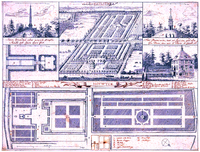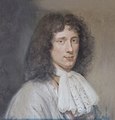|
Hofwijck  Hofwijck (Dutch pronunciation: [ˈɦɔfʋɛik]; or Vitaulium in Latin) is a mansion built for 17th-century politician Constantijn Huygens. It is located in Voorburg on the Vliet canal from The Hague to Leiden. Formal address of the cultural heritage is 2 Westeinde, Voorburg, the Netherlands,[1][2] but its location today is better known as the Voorburg railway station. ConstructionAfter he became a widower, Huygens bought land on the Vliet in Voorburg with plans to build a summer home. At the time it was quite fashionable to have a summer home on a river or canal, and old maps of Voorburg show Hofwijck as one of many. The building itself and the gardens (originally on both sides of the Vliet) were designed by Huygens himself in cooperation with the architect Jacob van Campen.[1] The estate was to be "a harmonious piece of paradise on earth, with a garden in God’s image and likeness." Huygens was very much inspired by the works of classical Roman architect Vitruvius.[2] Pieter Post was in charge of the actual building activities.[1] The building was erected in unplastered brick and is in the Classicist style. It stands in the centre of a square swan pond.[1] Hofwijck was inaugurated in 1642 in the company of friends and relatives.[2] Replica in China A replica of Hofwijck was built in Gaoqiao (Chinese 高桥) a planned city and neighborhood of the large community Pudong, Shanghai, People's Republic of China at 31°20′28″N 121°34′21″E / 31.34107°N 121.5724°E, next to another replica of the Nederlands Scheepvaartmuseum. CollectionIn the collection on display are various items from the Dutch Royal family that have to do with the work of either Constantijn or his son Christiaan. In the display room for Christiaan, various types of clockworks are shown, as well as some original clocks. Family paintings and furniture are on display throughout the building, and the library of Huygens (now a small office) contains many of his books, and offers the same strategic view out of the window at any boat that may appear (today one only sees highway traffic at eye level, and barge traffic at water level).
After Constantijn's deathWhen Constantijn died, his son, the scientist Christiaan Huygens, came to live there.[2] In 1750 the last Huygens to live there sold it.[1][2] Grossly neglected in later years, it was auctioned for demolition in 1849, which was avoided when it was acquired by politician Guillaume Groen van Prinsterer.[2] The "Hofwijck Association" acquired it circa 1913, when demolition loomed again.[1][2] It is now a museum, which opened its door for the first time on June 12, 1928.[2] It closed its doors in 1995 for restoration of the gardens and building and reopened since May 31, 2005 in presence of Beatrix of the Netherlands. On November 4, 2002, Hofwijck became a registered Monument as number 508184.[3] Trivia
Poem about HofwijckDe groote webb is af; en ’t Hof genoegh beschreven: Eens moet het Hofwijck zijn. wie kent den draed van ’t leven, Hoe kort hij is, hoe taeij? de snaer die heldste luijdt Scheidt d’eerste menighmael van leven en van Luijt, Verkracht en over-reckt, of met der tijd versleten. [...] 'k Wil Hofwijck, als het is, 'k wil Hofwijck, als 't zal wezen, de vreemdeling doen zien, de Hollander doen lezen. See alsoReferences
External links
(See Talk:Hofwijck/Sources in case of unclarity.) |












